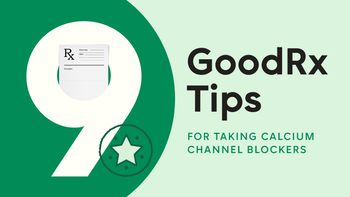
verapamil
Verapamil is a non-dihydropyridine calcium channel blocker. It's used to treat high blood pressure, arrhythmias, and chest pain (or angina) in adults. Verapamil works by slowing your heart rate and relaxing your blood vessels. This medication is taken by mouth typically about 3 to 4 times per day. Side effects can include constipation, dizziness, and nausea.

What is Verapamil?
What is Verapamil used for?
Chest pain (angina)
Prevention and treatment of certain types of arrhythmias
How Verapamil works
Verapamil is a non-dihydropyridine calcium channel blocker. It lowers blood pressure and helps with irregular heart rhythm (arrhythmia) by slowing your heart rate and relaxing your blood vessels. This also helps your heart to get more oxygen so it doesn't need to work as hard to pump, which can help with chest pain.
Drug Facts
More on Verapamil essentials

Get your GoodRx coupon

What are the side effects of Verapamil?
Common Side Effects
- Constipation (7%)
- Dizziness (3%)
- Nausea (3%)
- Low blood pressure (3%)
- Headache (2%)
- Swelling in the hands and feet (2%)
- Tiredness (2%)
Other Side Effects
- Trouble catching your breath
- Rash
- Flushing
Serious Side Effects
- Heart failure: chest pain, difficulty breathing, dizziness, tiredness, swollen legs and feet, bloating
- Dangerously low blood pressure: dizziness, lightheadedness, pale skin, feeling faint
- Liver problems: severe nausea, vomiting, right-sided stomach pain, fatigue, low or no appetite, yellowing of the skin or eyes
Source: DailyMed
More on Verapamil side effects
The following side effects have also been reported
Along with its needed effects, a medicine may cause some unwanted effects. Although not all of these side effects may occur, if they do occur they may need medical attention.
Check with your doctor immediately if any of the following side effects occur:
Less common
Blue lips and fingernails
blurred vision
burning, crawling, itching, numbness, prickling, "pins and needles", or tingling feelings
confusion
coughing that sometimes produces a pink frothy sputum
difficult, fast, noisy breathing, sometimes with wheezing
dizziness, faintness, or lightheadedness when getting up from a lying or sitting position suddenly
increased sweating
lightheadedness, dizziness, or fainting
pale skin
shortness of breath
slow or irregular heartbeat
sweating
swelling in legs and ankles
unusual tiredness or weakness
Some side effects may occur that usually do not need medical attention. These side effects may go away during treatment as your body adjusts to the medicine. Also, your health care professional may be able to tell you about ways to prevent or reduce some of these side effects. Check with your health care professional if any of the following side effects continue or are bothersome or if you have any questions about them:
More common
Difficulty having a bowel movement (stool)
headache
Other side effects not listed may also occur in some patients. If you notice any other effects, check with your healthcare professional.
Call your doctor for medical advice about side effects. You may report side effects to the FDA at 1-800-FDA-1088.

Pros and cons of Verapamil

Pros
Works well to help with blood pressure, irregular heart rhythm, or chest pain
Available as a lower-cost generic
Can be taken with or without food
Taken by mouth

Cons
Interacts with many medications
Can't approved for children
Can cause dizziness or swelling in your hands, feet, and legs
Needs to be taken multiple times per day

Pharmacist tips for Verapamil

Take verapamil with or without food at any time of day. If it hurts your stomach, try taking it with food to help. Just don't take it with grapefruit or grapefruit juice because grapefruit can raise the levels of verapamil in your body, which can cause side effects.
If you're taking verapamil for high blood pressure, make sure to measure and record your blood pressure at home and bring a record of your information to your medical appointments. This information will help your provider understand how well verapamil is working for you and if they need to make any changes to your treatment.
Take verapamil exactly as prescribed. Don't change your dose or suddenly stop taking the medication without talking to your provider first. Doing so can cause sudden changes to your blood pressure or heart rate. If you want to stop verapamil, ask your provider if it's safe to do so. You might need to lower your dose slowly over time before you can completely stop taking it.
Side effects, such as headache, dizziness, or constipation, are more noticeable when you first start taking verapamil and when your dose is raised. They should get better over time as you continue taking the medication. Talk with your provider if the side effects are becoming too bothersome.
Since verapamil can lower your blood pressure, you might feel dizzy when you start taking the medication and when the dose is raised. This should get better over time as you continue taking the medication and your body gets used to your new blood pressure. Also, it's recommended to limit or avoid alcohol because this can worsen dizziness. If you continue to feel dizzy, talk with your provider.
Swelling in your feet, ankles, legs, hands, or arms is a common side effect of verapamil. Talk to your provider if the swelling becomes too bothersome. They might recommend tips to ease the swelling, such as asking you to sit or lie down with your legs raised or to wear compression socks.
Verapamil can interact with many other medications. Tell your provider and pharmacist about all of the over-the-counter and prescription medications that you're taking.
If you're using verapamil for high blood pressure, make sure to have a healthy diet, including a low-salt diet, while taking verapamil so that the medication works even better to lower your blood pressure.
More on Verapamil tips

Frequently asked questions about Verapamil

How to save using GoodRx




What are the risks and warnings for Verapamil?
Verapamil can cause some serious health issues. This risk may be even higher for certain groups. If this worries you, talk to your doctor or pharmacist about other options.

Worsening heart failure
Risk factors: Heart failure | Other heart problems | Taking beta-blockers
Verapamil can worsen heart failure, especially in people who already have heart problems that affect how well blood is pumped to the rest of the body. Let your provider know if you experience symptoms of heart failure, such as chest pain, difficulty breathing, dizziness, tiredness, swollen legs and feet, or bloating.

Severely low blood pressure
Risk factors: Taking other medications that lower blood pressure | Dehydration
Verapamil can cause your blood pressure to drop too much, which can make you feel dizzy, tired, or lightheaded. This is a common side effect of blood pressure medications, especially when starting the medication and when the dose is raised. If your blood pressure drops too much and you feel too dizzy, make sure to sit down slowly while holding onto something. Let your provider know because they might need to adjust the dose of your medication. If you fall and hit your head, get medical help right away.

Slow heart rate or heart block
Risk factors: Taking beta-blockers or digoxin (Lanoxin) | Having medical conditions that slow your heart rate
Although rare, verapamil can cause or worsen heart block, which is when your heart rate is slowed down. This can cause you to feel weak or lightheaded and might even cause you to pass out. You're at higher risk if you're taking other medications that lower your heart rate, such as digoxin (Lanoxin) or a beta-blocker (e.g., propranolol (Inderal)), or if you have other medical conditions that slow your heart rate or affect your heart rhythm. Make sure your provider knows your entire medical history before starting verapamil. Ask your provider if you're not sure whether this medication is safe for you.

Liver problems
Although rare, verapamil can raise your liver enzymes, which can lead to liver problems if not properly treated. This typically occurred within 1 to 8 weeks of starting verapamil. Your provider might check your liver tests before you start this medication and regularly afterwards to make sure it doesn't become a serious problem. If you notice severe nausea, vomiting, right-sided stomach pain, fatigue, low or no appetite, or yellowing of the skin or eyes, get medical help right away.

Verapamil dosage forms
Typical dosing for Verapamil
Chest pain: The typical dose ranges from 80 mg to 120 mg by mouth three times per day.
Abnormal heart rhythms: The typical total daily dose ranges from 240 mg to 320 mg, split into smaller doses and taken by mouth three to four times a day.
High blood pressure: The typical starting dose is 80 mg by mouth three times a day.
Your provider might adjust your dose based on things like how well you're responding to the medication, your age, your height, if you have liver problems, and if you're having side effects.
There's also an injectable form of verapamil that's given into the veins (IV) for people in the hospital.
More on Verapamil dosage forms

Interactions between Verapamil and other drugs
More on Verapamil interactions
Using this medicine with any of the following medicines is not recommended. Your doctor may decide not to treat you with this medication or change some of the other medicines you take.
- Colchicine
- Dofetilide
- Eliglustat
- Flibanserin
- Lomitapide
Using this medicine with any of the following medicines is usually not recommended, but may be required in some cases. If both medicines are prescribed together, your doctor may change the dose or how often you use one or both of the medicines.
- Abametapir
- Acalabrutinib
- Acebutolol
- Adenosine
- Afatinib
- Alfentanil
- Alprazolam
- Alprenolol
- Amiodarone
- Aprepitant
- Atazanavir
- Atenolol
- Atorvastatin
- Avapritinib
- Benzhydrocodone
- Berotralstat
- Betaxolol
- Betrixaban
- Bevantolol
- Bisoprolol
- Bosutinib
- Brexpiprazole
- Brigatinib
- Bucindolol
- Bupivacaine
- Bupivacaine Liposome
- Buprenorphine
- Carbamazepine
- Carteolol
- Carvedilol
- Celiprolol
- Ceritinib
- Cilostazol
- Clarithromycin
- Clonidine
- Clopidogrel
- Clozapine
- Cobimetinib
- Codeine
- Conivaptan
- Cyclobenzaprine
- Dabigatran Etexilate
- Dantrolene
- Deflazacort
- Digoxin
- Dihydrocodeine
- Dilevalol
- Domperidone
- Doxorubicin
- Doxorubicin Hydrochloride Liposome
- Dronedarone
- Edoxaban
- Elexacaftor
- Encorafenib
- Entrectinib
- Epirubicin
- Eplerenone
- Erythromycin
- Esmolol
- Everolimus
- Fentanyl
- Fingolimod
- Fosaprepitant
- Fosnetupitant
- Hydrocodone
- Ibrutinib
- Ifosfamide
- Ivabradine
- Ivacaftor
- Ivosidenib
- Ketoconazole
- Labetalol
- Lacosamide
- Lefamulin
- Lemborexant
- Levobunolol
- Lovastatin
- Lumateperone
- Lurasidone
- Lurbinectedin
- Meperidine
- Mepindolol
- Mepivacaine
- Methadone
- Metipranolol
- Metoprolol
- Morphine
- Morphine Sulfate Liposome
- Nadolol
- Naloxegol
- Nebivolol
- Neratinib
- Netupitant
- Nilotinib
- Olaparib
- Oxprenolol
- Oxycodone
- Palbociclib
- Pemigatinib
- Penbutolol
- Pentazocine
- Pexidartinib
- Pindolol
- Piperaquine
- Pixantrone
- Ponesimod
- Propranolol
- Ranolazine
- Relugolix
- Rimegepant
- Selpercatinib
- Selumetinib
- Simeprevir
- Simvastatin
- Siponimod
- Sirolimus
- Sonidegib
- Sotalol
- Sufentanil
- Tacrolimus
- Talazoparib
- Talinolol
- Tazemetostat
- Temsirolimus
- Tertatolol
- Tezacaftor
- Timolol
- Tizanidine
- Tolvaptan
- Topotecan
- Tramadol
- Ubrogepant
- Venetoclax
- Vincristine
- Vincristine Sulfate Liposome
- Voclosporin
- Zanubrutinib
Using this medicine with any of the following medicines may cause an increased risk of certain side effects, but using both drugs may be the best treatment for you. If both medicines are prescribed together, your doctor may change the dose or how often you use one or both of the medicines.
- Apixaban
- Buspirone
- Cyclosporine
- Dalfopristin
- Digitoxin
- Dutasteride
- Flecainide
- Fosphenytoin
- Indinavir
- Lithium
- Metformin
- Midazolam
- Nevirapine
- Oxcarbazepine
- Pancuronium
- Phenobarbital
- Phenytoin
- Quinidine
- Quinupristin
- Rifapentine
- Rivaroxaban
- St John's Wort
- Suvorexant
- Tedisamil
- Telithromycin
- Tubocurarine
- Vecuronium

How much does Verapamil cost?

Verapamil contraindications
Severe left-sided heart failure
Severely low blood pressure, with systolic (the top number) blood pressure of less than 90 mmHg
Sick sinus syndrome (except if you have a ventricular pacemaker)
Second- or third-degree AV block (except if you have a ventricular pacemaker)
Having atrial fibrillation and certain accessory pathways in the heart
Active heart attack and congestion in the lungs

What are alternatives to Verapamil?
Chest pain (angina)
Prevention and treatment of certain types of arrhythmias
New chest pain
Long-term chest pain

What is the latest news about Verapamil?

Verapamil images
Get savings updates for Verapamil
Receive price alerts, news, and other messages from GoodRx about Verapamil and other healthcare topics and relevant savings offers.By signing up, I agree to GoodRx's Terms and Privacy Policy, and to receive marketing messages from GoodRx.
References
Best studies we foundAmneal Pharmaceuticals LLC. (2023). Verapamil hydrochloride- verapamil hydrochloride injection, solution [package insert]. DailyMed.
Chartwell RX. LLC. (2023). Verapamil hydrochloride- verapamil hydrochloride tablet [package insert]. DailyMed.
Dakkak, W., et al. (2023). Sick sinus syndrome. StatPearls.
Kulig, J., et al. (2010). Wolff-Parkinson-White syndrome and accessory pathways. Circulation.
National Heart, Lung, and Blood Institute. (2022). What is cardiogenic shock?
Richards, T. R., et al. (2014). Combining other antihypertensive drugs with β-blockers in hypertension: a focus on safety and tolerability. Canadian Journal of Cardiology.
Browse medications
View AllResearch prescriptions and over-the-counter medications from A to Z, compare drug prices, and start saving.

















